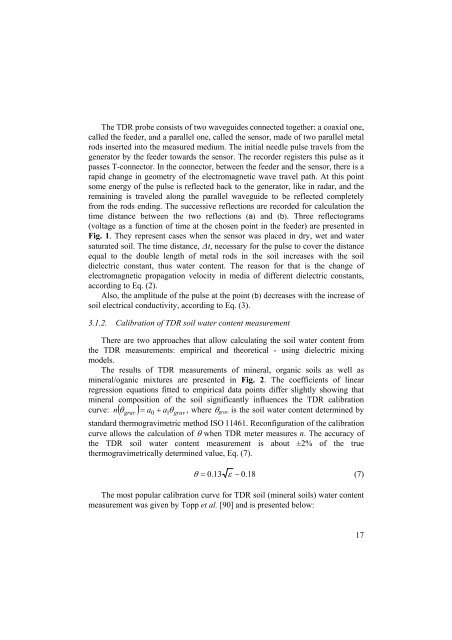ekS - Instytut Agrofizyki im. Bohdana DobrzaÅskiego PAN w Lublinie ...
ekS - Instytut Agrofizyki im. Bohdana DobrzaÅskiego PAN w Lublinie ...
ekS - Instytut Agrofizyki im. Bohdana DobrzaÅskiego PAN w Lublinie ...
Create successful ePaper yourself
Turn your PDF publications into a flip-book with our unique Google optimized e-Paper software.
The TDR probe consists of two waveguides connected together: a coaxial one,<br />
called the feeder, and a parallel one, called the sensor, made of two parallel metal<br />
rods inserted into the measured medium. The initial needle pulse travels from the<br />
generator by the feeder towards the sensor. The recorder registers this pulse as it<br />
passes T-connector. In the connector, between the feeder and the sensor, there is a<br />
rapid change in geometry of the electromagnetic wave travel path. At this point<br />
some energy of the pulse is reflected back to the generator, like in radar, and the<br />
remaining is traveled along the parallel waveguide to be reflected completely<br />
from the rods ending. The successive reflections are recorded for calculation the<br />
t<strong>im</strong>e distance between the two reflections (a) and (b). Three reflectograms<br />
(voltage as a function of t<strong>im</strong>e at the chosen point in the feeder) are presented in<br />
Fig. 1. They represent cases when the sensor was placed in dry, wet and water<br />
saturated soil. The t<strong>im</strong>e distance, ∆t, necessary for the pulse to cover the distance<br />
equal to the double length of metal rods in the soil increases with the soil<br />
dielectric constant, thus water content. The reason for that is the change of<br />
electromagnetic propagation velocity in media of different dielectric constants,<br />
according to Eq. (2).<br />
Also, the amplitude of the pulse at the point (b) decreases with the increase of<br />
soil electrical conductivity, according to Eq. (3).<br />
3.1.2. Calibration of TDR soil water content measurement<br />
There are two approaches that allow calculating the soil water content from<br />
the TDR measurements: empirical and theoretical - using dielectric mixing<br />
models.<br />
The results of TDR measurements of mineral, organic soils as well as<br />
mineral/oganic mixtures are presented in Fig. 2. The coefficients of linear<br />
regression equations fitted to empirical data points differ slightly showing that<br />
mineral composition of the soil significantly influences the TDR calibration<br />
n = a a θ , where θ grav is the soil water content determined by<br />
curve: ( θ grav ) 1 grav<br />
0 +<br />
standard thermograv<strong>im</strong>etric method ISO 11461. Reconfiguration of the calibration<br />
curve allows the calculation of θ when TDR meter measures n. The accuracy of<br />
the TDR soil water content measurement is about ±2% of the true<br />
thermograv<strong>im</strong>etrically determined value, Eq. (7).<br />
θ = 0.13<br />
ε − 0.18<br />
(7)<br />
The most popular calibration curve for TDR soil (mineral soils) water content<br />
measurement was given by Topp et al. [90] and is presented below:<br />
17
















